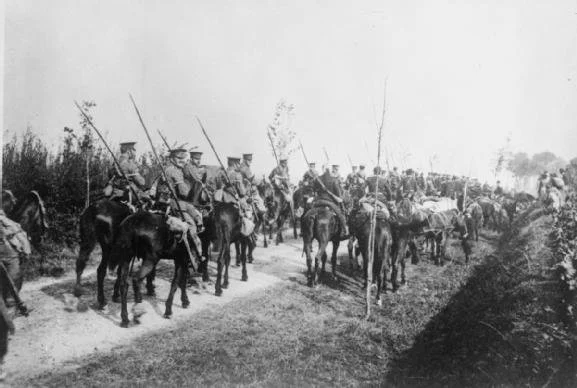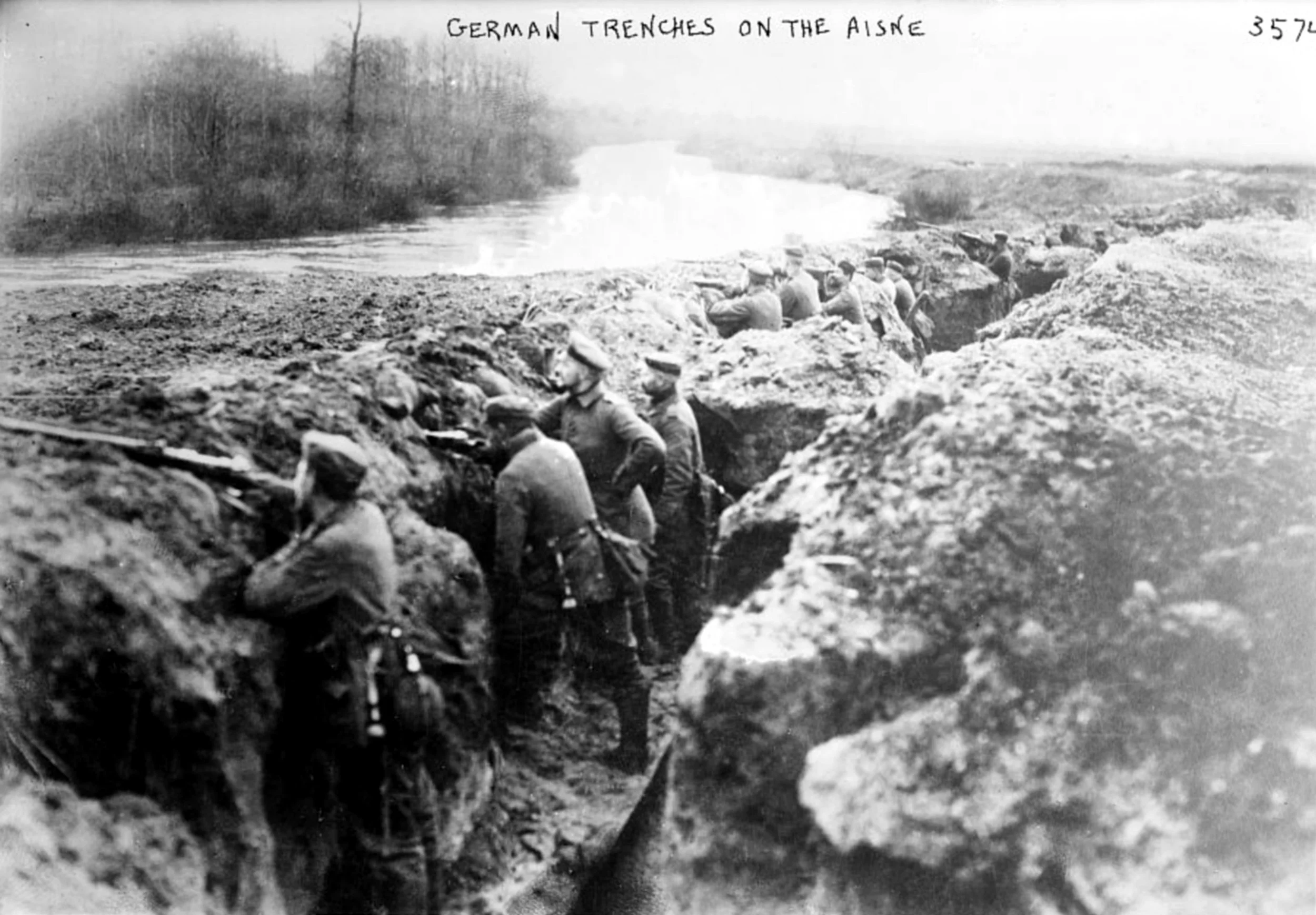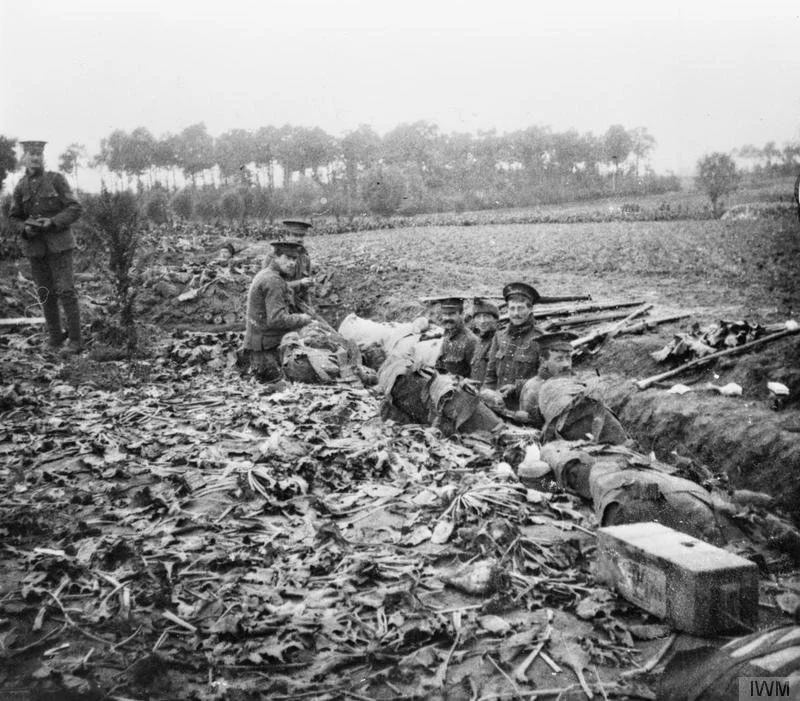Alfred Hyde, Corporal, 11th Battalion (H.D.) Royal Welch Fusiliers
Alfred Hyde was born in Wheathampstead, Hertfordshire in 1890 to Charles and Harriet Hyde. His father was a kitchen gardener. Alfred had five younger siblings.
By 1911, Alfred Hyde is in the military. His street address is “1st Cavalry Brigade, 19th Hussars, Wellington Lines, Aldershot”.
Above photo: A view of the newly completed Infantry barracks, Aldershot, circa 1860 (1)
“When Britian declared war on Germany on 4th August 1914, the 19th (Queen Alexandra’s Own) Hussars was stationed at Tidworth in Wiltshire. A and B squadrons went to France in August and C squadron in September.” (2)
In the “British Army World War 1 Medal Rolls Index”, it states that Alfred Hyde went to France on 10th September 1914. So, from that, one can ascertain that he was in C squadron. C squadron served with the 6th Division as part of the British Expeditionary Force.
“Following the outbreak of war, Field Marshal Sir John French’s British Expeditionary Force (BEF) was sent across the Channel to support France. These were well-trained and experienced soldiers.
Comprising only four (later re-enforced to six) infantry and one cavalry divisions - some 90,000 men - the BEF was tiny compared with the German and French armies.
On arrival, it was sent to a concentration area on the left of the French Fifth Army near Maubeuge on the Belgian frontier. This placed the BEF squarely in the path of the German First Army as it advanced through Belgium.
Above photo: British troops resting at Mons the day before the battle (Wikipedia)
On 22 August 1914, warned of the German advance by cavalry patrols, the BEF took up a defensive position along the Mons-Condee canal.
Above photo: Hussars on the look out (NAM)
The following day, the Germans blundered into them. They were stopped by accurate British rifle fire and suffered heavy casualties.
Despite the success at Mons, the BEF’s right flank was exposed by the withdrawal of the French Fifth Army and it too was forced to fall back. On 25 August, the French Commander, General Joseph Joffre, ordered a withdrawal to the River Marne.
Above photo: British dead at the Battle of Le Cateau (Wikipedia)
During the next 10 days the BEF carried out a 200-mile (320km) fighting retreat in hot weather. The BEF suffered thousands of casualties in a series of holding actions.
Above painting: 2nd day of the Retreat from Mons, 9th Queen’s Lancers charging German guns during the action of Elouges (Wikipedia)
At this point Field Marshal French (British Field Marshall) seems to have suffered a temporary loss of nerve. He decided that his troops needed to be pulled out of the line for a rest.
Above photo: The Retreat from Mons: 16th Lancers on the march, September 1914 (Wikipedia)
Aware of the impact that this would have on Anglo-French relations, Field Marshal Earl Kitchener, the Secretary of State for War, intervened in person and overruled him. On 3 September, the BEF withdrew across the Marne.
Believing that the French Fifth Army and the BEF were now beaten, the Germans decided to wheel east rather than west of Paris. This exposed their flank to a counter-attack on 5 September. The BEF marched into the gap between the German First and Second Armies and in the following week helped drive them back to the River Aisne.
The Germans dug in on the high ground of the Chemin des Dames ridge on the north bank of the Aisne. In mid-September, they defeated a number of attempts to dislodge them. The Allies then attempted to outflank the Germans to the north.
Above photo: The Germans dug in on the Aisne, September 1914 (Wikipedia)
This set in motion a period of fighting from late September to the end of November 1914 that is often called the ‘Race to the Sea’. Both sides attempted to outflank each other, gradually moving northwards towards the French-Belgian coast.
In October 1914, the BEF, now reinforced to twice its original size with Indian and Territorial divisions, was switched from the Aisne to Ypres in Belgium.
From 20 October to 22 November, it helped defeat a major German attempt to break through to the Channel ports. But the cost was high. By the end of the year, it had suffered over 90,000 casualties and the original force had been almost wiped out.
The Allied victory at Ypres marked the end of open warfare. Both sides dug in and a line of trenches 466 miles (750km) in length soon ran from the Channel to the Swiss frontier.
Above photo: Soldiers of the 2nd Battalion, Scots Guards in the hastily constructed trenches near Zandvoorde, October 1914 (IWM)
The Germans had captured large parts of northern France and Belgium. They built defenses in order to hold this ground, hoping to bargain with it when peace came. As a result, their trenches were substantial from the start.
The British and French always viewed trenches as temporary measures. Digging in deep risked sapping morale. Trenches would only be needed until the next ‘Big Push’: the attack that would bring the return of mobile warfare and the liberation of France and Belgium.” (NAM)
“9th Cavalry Brigade was formed in France on 14 April 1915 with the 15th Hussars and the 19th Hussars. On formation, the brigade was assigned to the 1st Cavalry Division to bring it up to a three brigade standard.
With the 1st Cavalry Division, the brigade took part in most of the major actions where cavalry could be used as a mounted mobile force. At other times it formed a dismounted unit and served in the trenches (as a regiment under the command of the brigadier).” (Wikipedia)
“In 1915, it took part in the Second Battle of Ypres and the Battle of Flers–Courcelette in 1916.
Above photo: Battle of Flers-Courcelette. 15-22 September. Troops of the 2nd Dragoon Guards (Queen's Bays) on the march approaching Hardecourt Wood, 18 September 1916 (IWM)
In 1917, the 1st Cavalry Division saw action at the Battle of Arras and the Battle of Cambrai.
Above photo: British cavalry riding through Arras, 11 April 1917 (NAM)
Above photo: British cavalry resting alongside the Arras-Cambrai road, April 1917 (IWM)
Above photo: Cavalry moving forward past a trench held by British infantry near Monchy-le-Preux, 13 April 1917 (IWM)
In 1918, the 1st Cavalry Division saw action at the Battle of Amiens, the Second Battle of the Somme and the battles of the Hindenburg Line.
Above photo: British cavalry at La Croiuselle, 1918 (Wikipedia)
It then took part in the Final Advance in Artois and the Final Advance in Picardy.
By the Armistice, the division was north of Mons, about 9 miles east of Ath on the Fifth Army front. On 16 November 1918, orders were received that the 1st Cavalry Division would lead the advance of the Second Army into Germany. Moving through Namur, the division crossed the frontier on 1 December and on 7 December the brigade reached the Rhine north of Cologne. On 12 December, the brigade crossed the Rhine on the Hohenzollern Bridge and reached its position on the perimeter of the bridgehead the next day.
Above photo: 18th Hussars in Cologne, December 1918 (Wikipedia)
On 30th October, while on leave, Alfred Hyde married Daisy Amelia Watkin. She had been born in Ellesmere, Shropshire. Her father was a blacksmith.
From here the trail goes dead until 1939 whereby the England and Wales Register records that Daisy Amelia Hyde is residing at Byletts Cottage, Pembridge with what would appear to be her daughter, Margurite D. Hyde also recorded in the register as Margurite D. Wright. The latter, aged 19, is a cook. If Margurite Hyde was Amelia Hyde’s daughter, she would have been born about 20 months after Amelia’s marriage to Arthur Hyde but there are no records to substantiate this. There are two young brothers, aged 10 and 11, with “Davies” as a surname that are also residing at Byletts Cottage.
Where Arthur Hyde resides in 1939 is not apparent from the Register of that year.
“The 1939 Register was designed to capture the details of every member of the civilian population on a specific date – military personnel were not recorded. Registration of members of the armed forces was dealt with by the military authorities, so the 1939 Register does not include service personnel in military, naval and air force establishments. Nor does it include members of the armed forces billeted in private homes, including their own homes. However, since conscription did not begin in earnest until January 1940, most people who subsequently served in the armed forces during the Second World War were still civilians in September 1939.” (3)
So, it is not impossible, especially given that there is no trace of Alfred Hyde in the 1939 register, that he had already enlisted in the Home Defence.
Above photo: 1939 Home Defence poster (Wikipedia)
“Unlike 1914–1918, there were relatively few service battalions, one being 11th (Home Defence) Battalion, Royal Welch Fusiliers, raised in 1939 as part of the Home Guard.
"In 1939 the United Kingdom was divided into regions for civil defence, each under a regional commissioner. The Welsh Region with headquarters at Cardiff consisted of the whole of Wales, while the counties of Shropshire and Herefordshire were part of the Midland Region, with headquarters at Birmingham. Militarily, Wales, Shropshire and Herefordshire came under Western Command, with headquarters at Chester, and formed Welsh Area with headquarters at Shrewsbury. This area was divided into four zones, each under a zone commander with powers to assist the civil defence authorities in an emergency.
Certain vulnerable points laid down by the War Office were to be guarded by troops of the recently formed National Defence Companies (Territorial Army Reserve). In 1939 ex-servicemen between the ages of 45 and 55 were encouraged to enlist in a Reserve Company of their local Territorial battalion, which was to be formed for home defence. It was proposed to form a platoon in each large town in the county and enlistment was for four years, and the rates of pay and allowances were as laid down for the Territorial Army. On being called up for service in one of the groups of the National Defence Companies, men, if passed fit, received a bounty of £5. They were clothed, armed and equipped as in the Territorial Army, and British Legion Headquarters were asked by the War Office to assist in raising a force of 25,000 men. However, as it transpired, events moved too quickly and it was found impracticable to deploy the National Defence Companies, and initially most of the vulnerable points were guarded by Militiamen from the depot in Welsh Area." (4)
On January 3rd, 1940, about four months after Alfred Hyde had enlisted in the 11th (Home Defence) Battalion, Royal Welch Fusiliers, he was accidentally killed.
He is buried at Pembridge (St. Mary) churchyard.
Above photo: Alfred Hyde’s headstone (Lee Oxenham, CWGC)
“THE CALL TO SERVE CAME, HE ANSWERED, AND DIED THAT WE MAY LIVE IN PEACE”
The Commonwealth War Graves Commission states that Alfred Hyde, at the time of his death, was the husband of Daisy Amelia Hyde of Shrewsbury. So, it is possible, given that the 1939 register “was designed to capture the details of every member of the civilian population on a specific date” that Amelia Daisy Hyde was only visiting or staying at her daughter’s residence in Pembridge when the 1939 England and Wales Register was compiled.
Amelia Hyde died in 1954 and is buried adjacent to her husband at Pembridge (St Mary) Churchyard.
Rory MacColl
Sources
1/ https://www.friendsofthealdershotmilitarymuseum.org.uk/garrison.012.html
3/ https://www.nationalarchives.gov.uk/help-with-your-research/research-guides/1939-register/
4/ “A History of the Herefordshire Regiment 1860-1967”


















